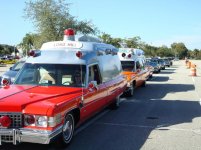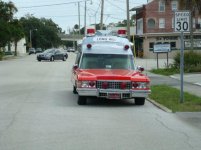I have been in the fire truck business for a long time in California. To be compliant with California code, an emergency vehicle has to have, at a minimum, one solid red light facing to the front and one flashing amber light facing to the rear. It was not uncommon back in the days of incandescent lights (and their inherent high amperage draws) to have a separate switch for the rear-facing flashing amber light. It was usually labelled "Rear Warn". On a long duration call, such as a car accident, to avoid battery drain on an idling vehicle, the minimum light array was left illuminated, leaving the flashing amber on while most of the other lights were turned off. The flashing amber light was also left on when parked on a roadway shoulder to warn approaching vehicles of personnel working around the vehicle and to avoid rear end collisions. Now that we have low-draw LED lights and higher-output alternators, this is no longer a concern.
Today, many fire trucks typically have only a "Warning Lights" (front, rear and sides) switch and a "Lightbar" (roof mounted) switch, both controlled by a "Master" switch to allow rapid departure from quarters. Most times all emergency lighting switches are left in the "on" position, with the "Master" switch in the "off" position. I have thought for many years that only two switches are required- one for "Lights" and one for "Noise" (sirens, etc.).




